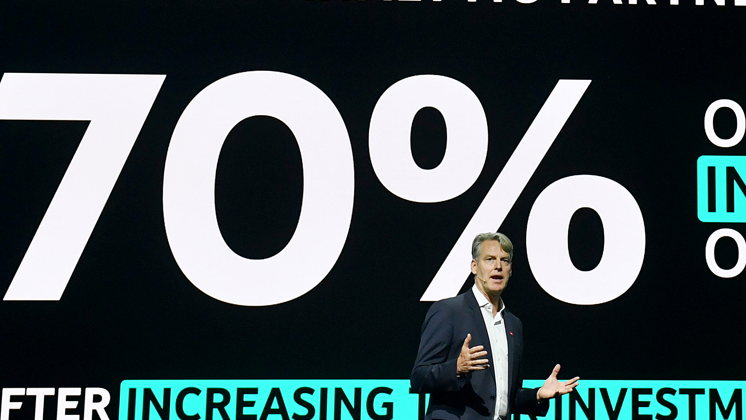YouTube Takes on TV With Frequency Caps and Shopping
Touts higher ROI that broadcast and cable, and other streamers

YouTube moved its Brandcast presentation to upfront week and took on the television networks.
YouTube used music and numbers, opening up with a performance featuring Jon Batiste of CBS’s Late Show with Stephen Colbert.
“Because of the incredible shifts we’ve seen in the media industry, we know, just like a lot of you know, this isn’t your parents upfront,” said Allan Thygesen, president, Americas, Google.
Upfronts 2022: Click Here for More Coverage
Thygesen said that while TV’s reach declines, YouTube generates higher return on investment for advertisers than traditional TV. He pointed to a recent MMM meta-analysis study done by Nielsen that found that YouTube’s ROI was 23% greater on average that TV’s ROI.
According to the same study, YouTube’s ROI was twice that of other online video players.
“YouTube‘s spends don't just deliver, they scale,” Thygesen said. Based on another study, he said that 70% of brands saw increased ROI on YouTube after increasing their investment year over year.
The smarter way to stay on top of broadcasting and cable industry. Sign up below
“While traditional TV ratings are going down, the TV screen remains important real estate for marketers,” he said.
More stats: there are 135 million people in the U.S. who watch YouTube on their televisions and YouTube has over 50% of the ad-supported streaming watch time on TV. A whopping 35% of those people can’t be reached by any other streaming platform. “They only watch YouTube,” Thygesen said.
Thygesen said YouTube has been working on streaming’s problems with people seeing the same ads over and over.
“We recently announced a new CTV frequency management solution … that allows advertisers to control the number of times people see their ads across YouTube and other CTV apps,” he said. “That includes nine of the top 10 most-watched CTV apps.”
“And today we're excited to announce our latest advance in frequency management that goes beyond CTV,” he added.
“Now you can complement your reach by actively setting your weekly frequency goal,” he told the advertisers and media buyers. “Advertisers will now be able to optimize how many times they receive your ads in a week, which means less wastage for you and less overexposure for your audience."
That can be a big problem. Thygesen pointed to yet more research that found that the heaviest TV viewers were exposed to a single ad 26 times over the course of the study. “You want to make audiences love your brand?“ he asked. “Showing them the same ads 26 times is not the way to do it.”
YouTube Goes Shopping
YouTube CEO Susan Wojcicki said the video platform was also adding shopping capabilities.
“People come to YouTube every day to make decisions about what to buy, and 87% of viewers say that when they‘re shopping or browsing on YouTube, they feel like they can make a faster decision about what to purchase because of all the information that we have in videos,” Wojcicki said.
“We have so much shopping activity that is already happening on YouTube. So we are making it even easier for viewers to discover and to buy so brands now can see the impact of shoppable video action ads that are converting customers from passive viewers to active buyers, and doing so at a lower cost,” she said.
YouTube will be adding features. It launched a way for video creators to tag specific videos with third products so users can easily see them, click, and then buy them all in the same video.
“Brands will be able to tap into the audiences for live stream events on YouTube,” Wojcicki said.
She announced that next month, YouTube will host its second annual Beauty Festival.
“It will be a shoppable live stream that will feature some of the beauty industry's top celebrities and creators. And we will have some exclusive product drops, with special partnerships with brands like Glossier and Lancôme,” she said.
Later this year YouTube will also launch a shopping feature that will let creators redirect live audiences to a brand channel so they can receive that traffic and learn about products. “We'll make it possible for two channels to come together to co-host a livestream, a shopping livestream, bringing communities together in a single stream,” she said.
The event closed with a rousing three-song set from Lizzo, who credited YouTube with getting her music discovered and busted her zipper in all the excitement.
“YouTube has always been a home for me to share my music and own my voice,” Lizzo said. “Performing at YouTube‘s Brandcast alongside my fellow creators is a way to remind the industry that when an artist can truly be self-expressive, creativity mixes with authenticity in really profound ways.” ■
Jon has been business editor of Broadcasting+Cable since 2010. He focuses on revenue-generating activities, including advertising and distribution, as well as executive intrigue and merger and acquisition activity. Just about any story is fair game, if a dollar sign can make its way into the article. Before B+C, Jon covered the industry for TVWeek, Cable World, Electronic Media, Advertising Age and The New York Post. A native New Yorker, Jon is hiding in plain sight in the suburbs of Chicago.

